
By Neil Patel – Quicksprout – http://bit.ly/1bQL13C
Around a month ago, I ran a Crazy Egg test, which showed that most people weren’t scrolling and reading the copy on NeilPatel.com.
Because of the data, I decided to run an A/B test on the homepage. The current homepage has 1,292 words. The form fields are way below the fold, so I felt the design may be decreasing my conversion rate.
I created a new version of the homepage, as seen below, that only contained 488 words with form fields higher on the page:

Can you guess which one converted better? The original converted 7.6% better than the new variation. And it didn’t just end there. The leads from the long form version of the page were better in quality, meaning they were more qualified than the leads that came from the new variation.
So, you are probably wondering, how can that be… right? Well, I did some digging and learned that in most cases long form copy doesn’t just boost your conversions, but it also increases your rankings too.
Let’s look at the data:
Content really is king
The serpIQ analyzed the top 10 search results for over 20,000 keywords and noticed a pattern.
The average content length for a web page that ranks in the top 10 results for any keyword on Google has at least 2,000 words. The higher up you go on the search listings page, the more content each web page has.
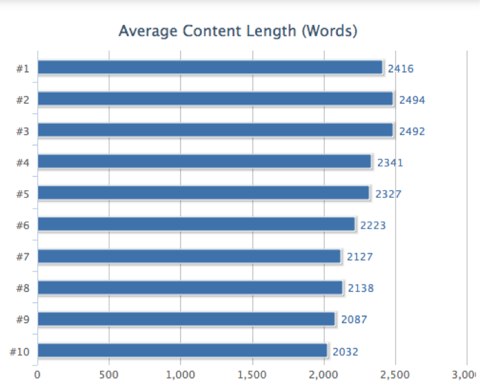
Based on the graph above, you can see that the first result typically has 2,416 words and the 10th result has 2,032 words. This shows that Google prefers content rich sites.
The interesting part is that Google doesn’t prefer more content because it feels it is more valuable. It actually prefers content rich sites because data shows you like it, which leads me to my next point.
Content rich sites get more links
People feel content is so valuable that they are willing to link to in-depth content more than they are willing to link to content that is short.
Back in 2011, SEOmoz analyzed the content on their blog to see if there was a correlation between word count and backlinks.
Here is a breakdown of the number of blog posts they have and the word count for each of them:
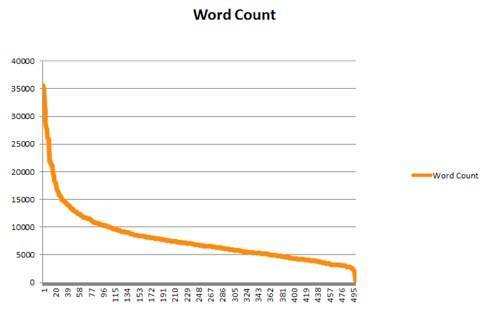
And here is a breakdown of how many links each of those blog posts received:
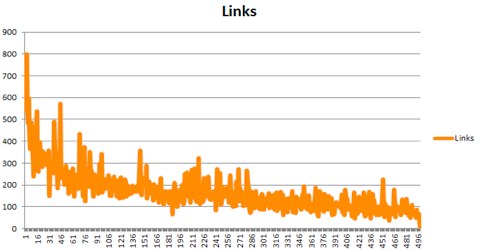
The data above shows a direct correlation between the length of the content and the number of people who linked to it. As you already know, the more links a web page has, the higher it will typically rank on search engines… which is why the average web page that ranks on the first page of Google has over 2,000 words of content.
The social web prefers content rich pages
I took the 327 blog posts I have written on Quick Sprout and broke them down into two buckets. The first bucket contained blog posts that were fewer than 1,500 words, and the second contained posts that were greater than 1,500 words. I then analyzed how many tweets and Facebook likes each post got.
Posts that were under 1,500 words, on average received 174.6 tweets and 59.3 Facebook likes. Posts that were over 1,500 words, on average received 293.5 tweets and 72.7 Facebook likes.
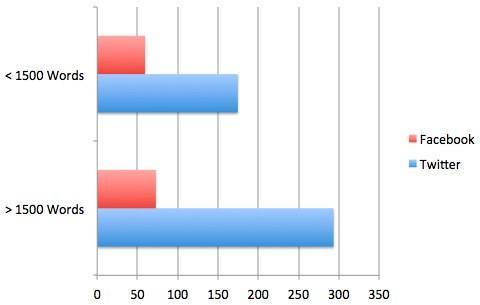
What follows is that if a post is greater than 1,500 words, on average it receives 68.1% more tweets and 22.6% more Facebook likes than a post that is under 1,500 words. When you take into account that search engines take social signals into account when ranking sites, it reinforces why web pages with lengthier content rank higher.
You are becoming a better searcher
Based on data released by Hitwise, you are starting to use longer search queries when you search. 8-word search queries are up by 34,000%.
- 1-word searches = 20.29% (previously was 19.02%)
- 2-word searches = 23.65% (previously was 32.58%)
- 3-word searches = 21.92% (previously was 25.61%)
- 4-word searches = 14.89% (previously was 12.83%)
- 5-word searches = 8.68% (previously was 5.64%)
- 6-word searches = 4.65% (previously was 2.32%)
- 7-word searches = 2.49% (previously was 0.98%)
- 8-word searches = 3.43% (no one did 8-word searches in 2004!)
The general trend is that the percentage of people who are searching for 2 or 3-word phrases is decreasing and the percentage of people who are searching for 4, 5 or even 8-word phrases is increasing.
If you want to capitalize on this, consider boosting the amount of content on your website as the more words you have on each page, the more likely you are to rank for long tail keywords.
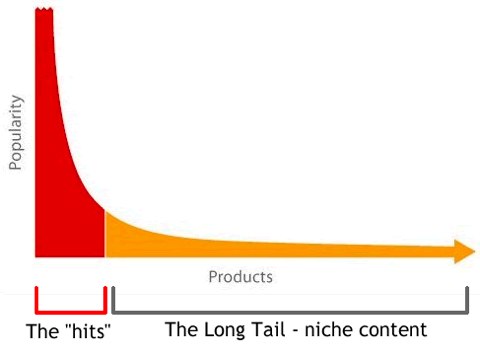
I know these long tail keywords aren’t searched for a lot, but when you combine them all and compare them to head terms, there is much more traffic in the long tail. For example, with Quick Sprout, 71.28% of the search traffic comes from long-tail keywords. The beautiful part about those keywords is that they are less competitive, which means it is easier to rank for them, and they convert better than head terms. On Quick Sprout, long-tail keywords convert 121.92% better than head terms.
Longer form copy converts better than short copy
As you saw above, NeilPatel.com converted better when there was more content, even when the form fields were way below the fold.
And it isn’t just with NeilPatel.com. We had the same experience with Crazy Egg: the long form version of the homepage converted 30% percent higher than the short version.
Others experienced this as well. Marketing Experiments ran three tests to see whether long or short copy converted better. They drove Google AdWords traffic to both copies and saw that in each case the long copy converted better.
In the first test, the long copy converted better by 40.54%. In the second test, there was a much larger difference. The short copy had a negative ROI of 66%, and the long copy had a positive ROI of 50%. In the last test, the long copy converted better by 45.45%.
Conclusion
I hope this post convinces you that you need to start writing longer copy. Whether it is sales pages, blog posts or anything else, if you want more traffic and higher conversions, you should consider long form copy.
Before you start to write long form copy, however, there are a few things you need to know:
- You can’t write crappy content – you can’t crank out 1,000 web pages with 2,000 words each and expect your rankings or conversions to go up. You have to write really great content. Good content gets the tweets, links, conversions, and higher rankings.
- Copy doesn’t always boost conversions – for some web products or web pages, shorter copy may convert better. You just have to test things out. The reason it works well for Crazy Egg or NeilPatel.com is because we first surveyed potential customers and found out all of the objections they had with the services. We then wrote copy that answered each objection. In addition, we threw a ton of Google AdWords traffic to landing pages with different headline variations and call-to-action buttons to figure out what copy appealed to our customers.
- Social media helps – the reason copy does well on blogs like Quick Sprout and SEOmoz is because we have strong social media accounts with lots of followers. Sure, long copy may do better, but in general, almost all of our content does well because we built up our social presence. Writing lengthy content won’t get you a ton of tweets and likes if you haven’t built up your social media accounts first.
- Don’t ramble – I once heard Om Malik say, “if you can write a blog post in 1,000 words, you can write it in 500 words. And if you can write a post in 500 words, you can write it in 250 words.” The point Om was trying to make is that you shouldn’t ramble: just get to the point. If your content is naturally long, great! If it isn’t, don’t fluff it up to increase your word count.
Have you noticed any other interesting trends when it comes to long versus short copy debate?
